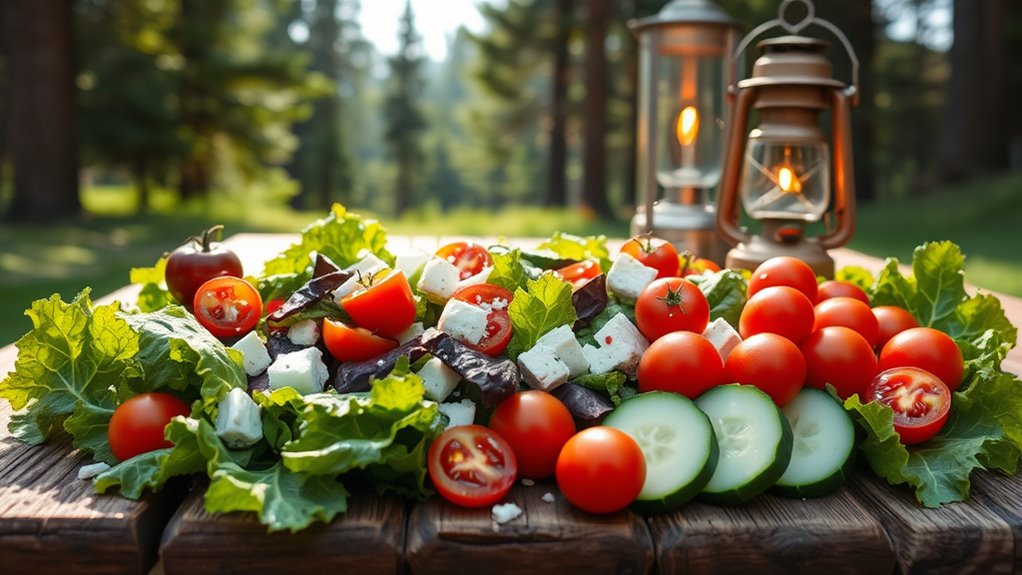Pack a camping salad that travels light and stays crisp. Start with sturdy greens, add cucumber, shredded carrot, cherry tomatoes, corn or beans, and a protein like cheese or nuts. Prep in a compact kit: knife, board, leakproof jars for dressing, pre-measured portions, and durable containers. Layer greens, toppings, and dressing separately for easy, mess-free meals by the fire. Use simple, travel-friendly dressings and finish with herbs or citrus. Curious what more you can tweak on the trail? Keep going.
Ingredients and Quantity
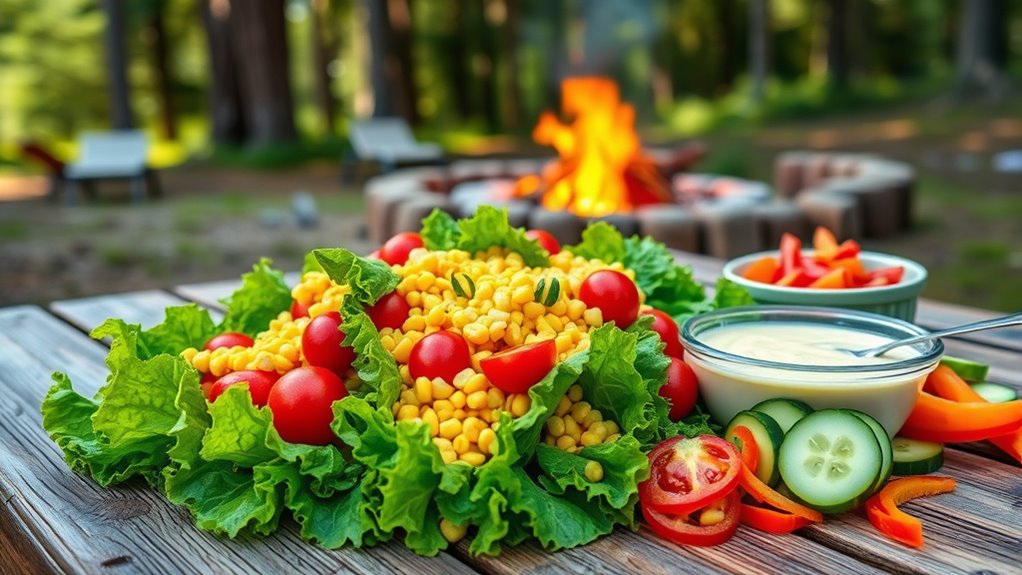
When it comes to camping salad recipes, start with a clean base of greens and a handful of sturdy veggies that stand up to a trek. You’ll grab fresh ingredients that travel well, measuring by rough cups or handfuls, not scales. Aim for a balance: greens, crunch, and color, plus a few protein nuggets to sustain your climb. Use simple dressings in small, leakproof bottles. For quantities, think: 2 cups chopped greens, 1 cup sliced cucumber, 1/2 cup shredded carrot, 1/2 cup cherry tomatoes, 1/4 cup corn or beans, 2–3 oz cheese or nuts. Pack 1–2 servings per person, plus extra for sharing. Table below shows quick ideas for fresh ingredients and salad variations.
| Greens | Veggies | Extras |
|---|---|---|
| Spinach, romaine | Cucumber, carrots | Feta, nuts |
| Kale, arugula | Bell pepper, corn | Chickpeas, seeds |
| Lettuce blends | Tomatoes, onions | Avocado, olives |
| Arugula | Radish, snap peas | Grilled chicken, tofu |
Preparations
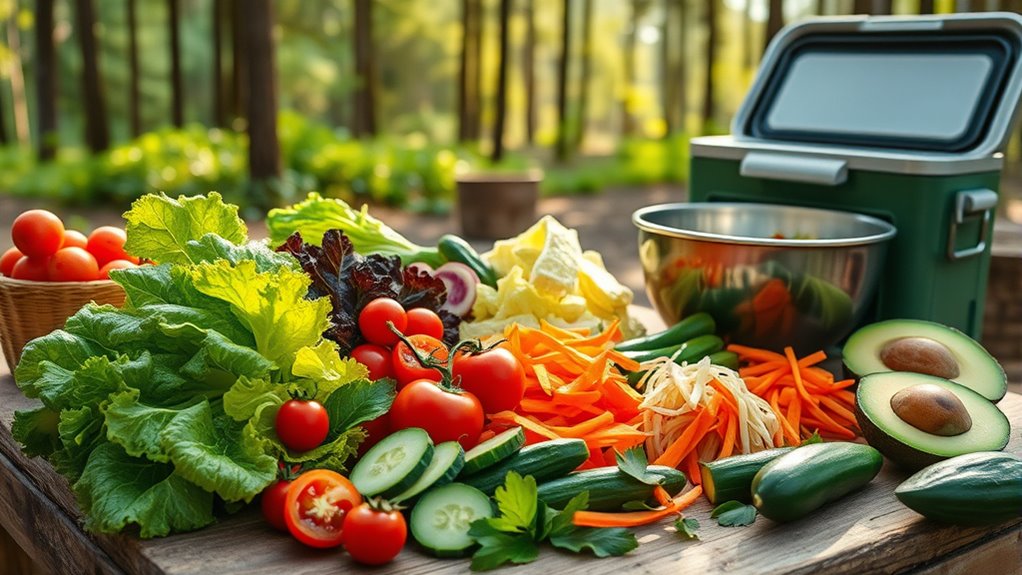
To prep for your camping salads, gather a compact kit: a sharp knife, a sturdy cutting board, a half-lidded container for greens, and small, leakproof jars for dressings. In the Preparations phase, you’ll wash, dry, and slice with intention, keeping textures crisp and colors vibrant for the trail. Trim stems, tear lettuce by hand, and chunk sturdy vegetables for quick bites. Plan your meal prep by layering components: greens on bottom, toppings in separate compartments, and dressings sealed tight. Label jars if needed, so flavors stay bold. Pre-measuring portions saves time at the campsite. Consider a simple salad dressing that travels well—oil, lemon, salt, and a pinch of herb. Ready, you’ll assemble at the site, savoring fresh, liberated meals on the open road.
Kitchen tools or Kitchenware Required
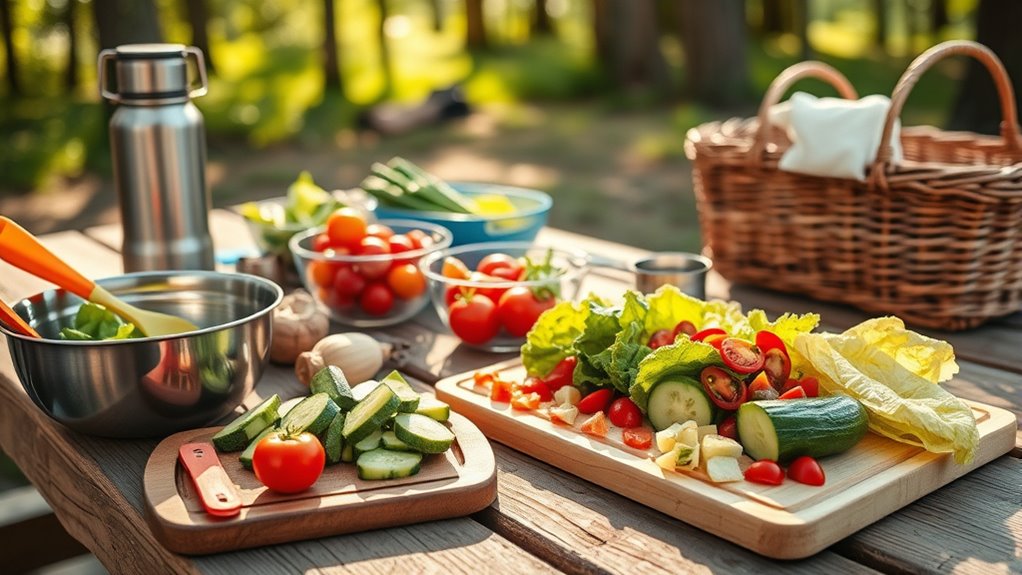
For camping salads, you’ll want a compact, durable kit that travels light but handles rough trails. You’ll need reliable salad containers and portable utensils that withstand the outdoors, wipe clean fast, and nest together for space-saving efficiency. Choose BPA-free containers with secure lids to prevent leaks, and perimeters that stack without tipping. A small cutting board, knife, and a folding utensil set cover most tasks, from chopping to tossing. Pack a spill-proof dressing bottle and a small towel for quick cleanup. Table follows with essentials:
| Item | Purpose | Benefit |
|---|---|---|
| Salad containers | Storage | Keeps ingredients fresh |
| Portable utensils | Eating | Lightweight, versatile |
| Cutting board & knife | Prep | Safe, compact |
Stay adaptable, savor the journey, and keep gear light yet capable.
How to Cook
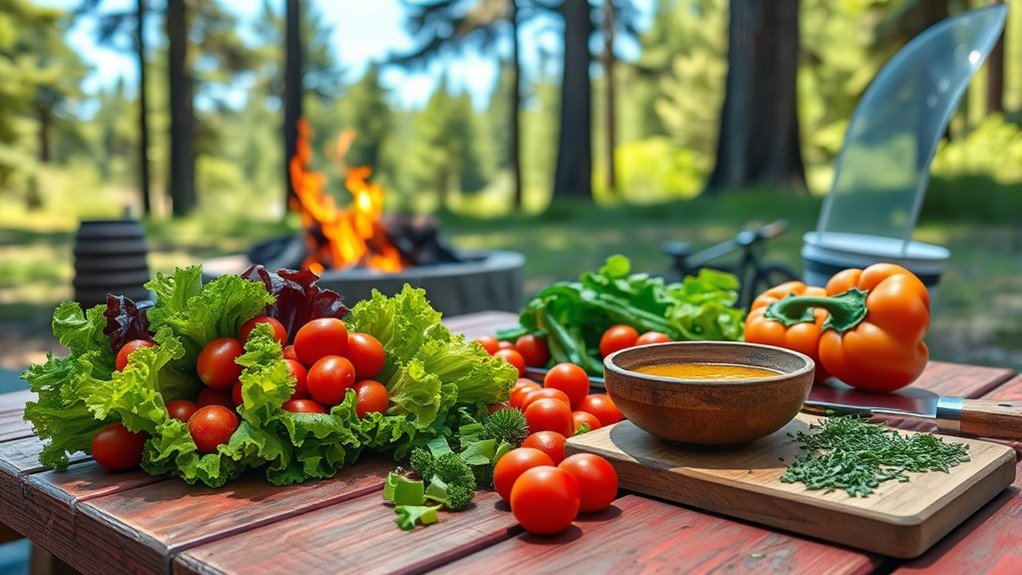
- Start with a hot pan, a reliable heat source, and ingredients suited for outdoor cooking.
- Use practical cooking techniques to keep fuel consumption low and flavors bright.
- Plan meals efficiently by pre-measuring portions and grouping ingredients by cook time.
- Organize your cooking steps to minimize stove use and movement.
- Cook by searing, sautéing, or simmering over steady flames.
- Allow ingredients to rest after cooking to let flavors meld.
- Adapt to environmental factors like wind, rain, and altitude as part of the cooking challenge.
- Trust your senses and adjust heat intuitively as needed.
- Finish dishes with bright touches such as fresh herbs, citrus, or a splash of oil.
- Emphasize flexibility, efficiency, and confidence in your trail cooking approach.
How to Serve

After you’ve plated and tasted your camping salad, the focus shifts to how you serve it, so it stays fresh, appetizing, and easy to share on the trail. You’ll want simple, rugged presentation that celebrates the outdoors: lightweight bowls, reusable forks, and a single-dish approach that minimizes waste. Keep dressing options in small, sealable containers so everyone can customize without soggy greens. For serving suggestions, layer ingredients in clear, durable cups or a leakproof to-go bowl, letting colors pop and textures stay crisp. Pack toppings separately—croutons, seeds, and herbs—so you control restorations mid-hike. Offer a quick toss before eating, or let companions mix their portions at the campfire, preserving freshness and spontaneity.
Tips
When you’re packing and prepping, small tweaks can elevate your camping salad game without slowing you down. You’ll want simple, reliable tips that travel well and stay crisp. Choose camping essentials like sturdy containers, a compact knife, and a reliable cold-pack system to keep greens fresh on the trail. Go lightweight with pre-cut veggies, portable protein, and durable dressings in squeeze bottles. For efficiency, prep once and assemble later: greens, crunch, and flavor boosters separate until serving. Rotate salad variations to suit weather and appetite—try tangy citrus, smoky beans, or herbaceous vinaigrettes. Pack a small whisk or fork for quick emulsions. Keep seasonal, local accents in mind for vibrant, fearless flavor. Stay mindful of cleanup, and your salad stays delicious, no matter where you roam.
Food Value and Benefit
The prepared camping salad offers excellent food value by providing sustained energy, essential nutrients, and quick recovery support for outdoor activities. This recipe combines leafy greens, colorful vegetables, protein sources, nuts, seeds, citrus, and hearty grains or beans, making it a nutrient-dense meal that fuels your body efficiently on the trail.
Benefits of eating this recipe include:
- Sustained energy release for long-lasting endurance
- Stabilized blood sugar levels to maintain steady focus
- Enhanced muscle recovery after physical exertion
- Boosted immune system function
- Improved mood and mental clarity
- Support for digestive health and nutrient absorption
Key vitamins and minerals found in this recipe:
- Vitamin A (from leafy greens and colorful vegetables) for eye health and immune support
- Vitamin C (from citrus fruits) to enhance immunity and antioxidant protection
- Vitamin K (from leafy greens) for blood clotting and bone health
- B vitamins (from grains and beans) for energy metabolism
- Iron (from beans and leafy greens) to support oxygen transport in the blood
- Magnesium (from nuts and seeds) for muscle function and energy production
- Potassium (from vegetables and fruits) to maintain fluid balance and muscle contractions
This well-rounded salad is a reliable, nourishing meal that supports your body’s needs on every outdoor expedition.
Frequently Asked Questions
How Long Can Camping Salad Stay Fresh Without Refrigeration?
You can’t keep camping salad fresh for long without refrigeration—usually up to a few hours, depending on temperature considerations. Pack perishable ingredients separately, use coolers, and rely on storage solutions that keep you adventurous, free, and safe.
What’s the Best Dressing for Outdoor Meals?
A invigorating breeze is a compass; your best dressing is bright vinaigrette variations, using citrus or herbs, and you’ll love creamy options for contrast. You crave freedom, so craft bold, practical, adventurous flavors for outdoor meals.
Can I Swap Ingredients for Dietary Needs?
Yes, you can swap ingredients for dietary needs, embracing ingredient substitutions and dietary restrictions. You’ll craft a practical, adventurous plate, feeling free to experiment, adapt, and savor every bite while keeping flavors bold and your trail-ready meals inclusive.
Which Greens Hold up Best on a Hike?
Like a trusty compass, you’ll want greens that endure. Spinach durability and arugula benefits shine; these hold up best on a hike, staying crisp longer while you roam, practical, adventurous—freedom-fuel for your trail-side munching.
Any Make-Ahead Tips for Packing Salad?
Yes—prep ahead with airtight containers, then layer greens with dry add-ins and dressing separately. Salad storage stays fresh, and packing techniques keep flavors bold, so you roam freely while crunch stays crisp and adventurous.
